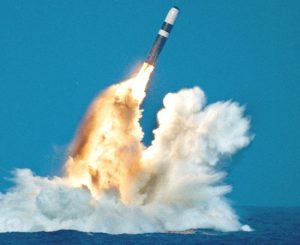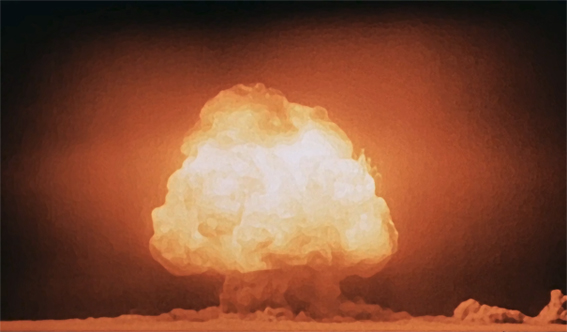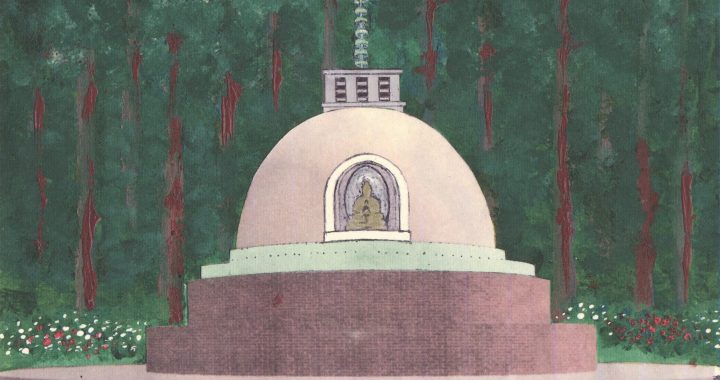By Leonard Eiger
Today marks the anniversary of the day in which the world entered the atomic age. On July 16, 1945, at 5:29:45 AM at the Alamogordo Test Range, on the Jornada del Muerto (Journey of Death) desert, in the test code-named Trinity, the experimental device known as the “Gadget” was detonated, creating a light “brighter than a thousand suns.” A mere 6 kilogram (13.2 pound) sphere of plutonium, compressed to supercriticality by the surrounding high explosives, created an explosion equivalent to 20,000 tons of TNT (20 Kilotons).
Was this, as thought nuclear physicist Robert Oppenheimer, the beginning of the end? These scientists had “become death”, and they had created what could become (quite literally) “the destroyer of worlds”(Oppenheimer quoted a verse from the Bhagavad Gita which read, “I am become Death, the destroyer of worlds.”) The nuclear genie (referred to in my previous post) was out of the lamp and now, 64 years later, we have one final wish left. Will it be for the genie to return to the lamp? We had better hope so! 
Less than one month after the Trinity test, the United States dropped two atomic bombs – on the cities of Hiroshima and Nagasaki – that killed over 100,000 people in less time than it took me to type a few of these words. As many as 220,000 were dead from the effects of radiation by the end of 1945. Even today, 64 years later, survivors and subsequent generations suffer the effects of radiation.
So began a journey (with the test known as Trinity) that has led humanity down the perilous road of preparation for its own destruction. Scientists have continued to seek the power of gods, creating ever more destructive nuclear devices over the years, and military planners continued asking for more of these awful weapons in every shape and form (and method of delivery).
It is a time to ponder the perilous journey we have taken since that first test of a nuclear bomb in the desert of New Mexico. Since the United States dropped the first two bombs on Japan in August of 1945, nuclear weapons have never been used by one nation against another, although we have neared that precipice numerous times. Since those first two bombs the U.S. reached a peak stockpile of 31,255 warheads (as of 1967) at astronomical costs, both economic and human.
As the United States and the Soviet Union fought the Cold War from their respective development laboratories and weapons factories, planners on each side continuously struggled to stay ahead of the other. Somewhere along the way, someone got the bright idea that submarines loaded with nuclear tipped missiles were the perfect way to keep the enemy guessing. After all, a sub bristling with nuclear weapons could sneak around the seven seas, ready to launch an attack, totally surprising the enemy.
Trident was the culmination of this demonic drive – the ultimate first strike weapon; today some of the 14 Trident nuclear submarines, loaded with Trident D5 missiles, silently roam the seas, ready to launch their deadly missiles on the order of the President of the United States. Just one of these submarines would, if it were to launch all its missiles armed with a full complement of 455 kiloton warheads (rather than the puny 100 kiloton model), unleash the equivalent of nearly 7000 Hiroshimas (the Hiroshima bomb was between 12.5 and 15 kilotons), and could kill hundreds of millions of people. What madness is this?
Yet, while tens of thousands of people labored to develop and build this system of mass destruction (Trident), others worked to resist the madness – to let others know that we were preparing the seeds of our own destruction. For Trident, it all began with the early 1970’s when a missile designer named Bob Aldridge was at Lockheed Missiles and Space Corporation working on the first Trident missile design. Bob recognized something about the maneuvering reentry vehicle that he was designing; it was designed “to home-in on underground missile silos in a nuclear first strike” (Ground Zero Newsletter, Vol. 7, Issue 3, July 2002). Bob’s conscience got the better of him (something that has not happened to the vast majority of nuclear weapons scientists or engineers), and after a family retreat following Christmas 1972 Bob submitted his resignation letter to Lockheed.
A year later Bob met with Jim and Shelley Douglass and told them of his remarkable journey from missile designer to student of nonviolence, and briefed them on the plans to create what would be known as Sub Base Bangor (West Coast home of the new Trident fleet) on the shores of the Hood Canal in Washington State, just 20 miles from Seattle. And so the seeds of Ground Zero Center for Nonviolent Action were sown by a person with the courage to follow his convictions.
In 1977 Jim Douglass and John Williams found 3.8 acres of land with a small house right next to the Bangor fence. What a find! A year later (the first Trident missile was deployed in October 1979) Bob Aldridge sent Jim and Shelley Douglass an urgent letter warning of the first strike threat that Trident represented. First strike meant that Trident would likely be used to deliver a preemptive surprise attack of overwhelming force on the Soviet Union (not a pretty picture).
Jim and Shelley Douglass, and many others continued building the Ground Zero community (which was preceded by the Pacific Life Community) as they worked in common resistance to Trident; blocking the railroad tracks on which the “White Trains” brought the nuclear warheads, leafletting at the gates of Bangor and blocking the gate, and building awareness of the dangers (as well as the immorality and illegality) of Trident and all nuclear weapons.
Today, the people of Ground Zero Center for Nonviolent Action are still dedicated to the abolition of Trident and ALL nuclear weapons. This is no naive pipe dream. Humanity is at (or is nearing) a fork in the long road that began with Trinity. Which fork we take (and the future of humanity) will depend on the hard work of people like you and me. Please join us as we remember the anniversaries of the atomic bombings of Hiroshima and Nagasaki, and rededicate ourselves to the long struggle for a world free of the threat of nuclear annihilation.




